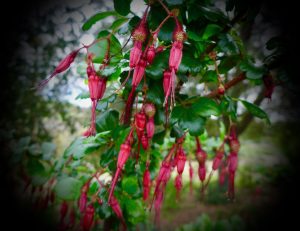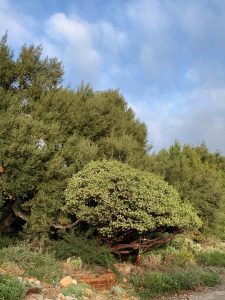So far, this is the winter we have been waiting for. Nice rains, perfectly timed for good infiltration into the soil, nice sunny days to promote plant growth between storms, and more rain in the forecast. With only a few normal frost events, and no severe freezes (yet), your natural garden should be looking great, and is poised to look even better as the days get longer, the soil warms up, and spring springs into action.
At Tree of Life Nursery last year we had a total seasonal rainfall of around 6”. This year, we already have 9.5” and at this writing (1/31/19) a good storm is approaching with another right behind. For natural gardens and native plants in general, whether in your garden or out in the wild places, it’s always all about rain. California’s classic Mediterranean climate is defined by cool season rains and a dry period of 6-8 months with no rain. When rains are sufficient, or even generous, the dry season is easier on the vegetation, as moisture has been soaked deep into the soil where the plant can find as needed in say… July/August. So as gardeners, we can already be smiling about this coming summer. But wait! Let’s not forget spring. 2019 should be a good one!

Watering
Unless you have a brand new garden or newly planted plants located in sunny, warm or windy places (where the nursery root ball might dry out between storms) you should be applying zero water to your garden. If you need to water a new plant, don’t start your sprinklers. Simply soak the root ball and the soil around the new plant with a watering can or a soft rain nozzle on your hose.
Related to Watering
Now is the perfect time to observe and learn. In our watering guide, How to Water Native Plants, we talk a lot about a “deep soak” during the dry season. We emphasize how to do this: apply approximately .5” of sprinkler precipitation every morning, 3 days in a row for a total of 1-1.5” water per irrigation, approximately every 3-4 weeks. Now notice how the winter rains this year have been almost exactly that! Also in our watering guide we talk about “refreshing sprinkles.” If you’re not familiar with these terms, download the publication and read up on it, while you watch nature doing it according to formula this spring. Log this information away and apply what you have learned when your garden needs its first 2019 “deep soak” watering, around May or June.
Pruning
Always prune in anticipation of what the plant is getting ready to do. In commercial and industrial landscapes everywhere we see plants being severely pruned (mutilated) so frequently that they cannot possibly be healthy. Natural gardens will benefit from selective artful pruning and grooming with good horticulture as the driver. If you have sunflower, sage, sagebrush, buckwheat or other soft-branched shrubs that can be shaped and headed back now so they will put on new growth in March, go for it. Woody shrubs as a general rule should be thinned in fall (if at all!) but now is not too late if you see a Rhus, coffeeberry, or a toyon that needs a little directional pruning. Remember to periodically sanitize your tools in a 10% bleach solution, (or alcohol or Lysol) to avoid spreading disease. Woody shrubs should not be headed back, hedged, or tip pruned at this time.
Weeding
Winter weeds might be seeing their prime germination time right now. Easier to pull them out while they are small.
Mulching/Top dress
Let the plants drop their own leaves and shade their own root systems with their own low branches. If you have mulch in place, now would be a great time to scratch it up with a little 3-prong cultivator, to get some new air into the top layers of soil.
Feeding
Wait until the soils start to warm a little and the plants are actually growing. Maybe March.
Troubleshooting – Varmints, Pests and Diseases
See January’s post for information on insect galls on manzanita and ceanothus. Watch for aphids on new growth and tender flowering stems on all your plants. One of the most satisfying activities is to put your pistol nozzle on your hose, tenderly cup the branch tip with aphids in your hand, and with spray nozzle in other hand, blast the little devils into oblivion. Basically wash off your plant’s stems with a strong spray, without damaging the plant. Repeat as necessary as the life cycles of those little guys can be quite vigorous.
Annual Wildflowers
The seed you sowed, November through January should be sprouting. It’s too late to sow wildflower seed now for good flowering in Spring, but if you’re feeling lucky, do it today, as early in February as possible. Maybe we’ll have a long gentle spring and flowers into early summer.

Adding New Plants
Before a rain, in the rain, after a rain… this is the ideal time to add new plants to your garden. And this is a great year to do it. OK if it’s pouring, the mud and mess is not worth it, but it is really fun to put new plants in the ground during a gentle rain.
Engage
Throughout southern California, there are various hotlines and websites where you can get current updates on wildflowers in many of our parks and natural areas. Here’s a thought. Watch your garden as the manzanitas (blooming now) and the everything else (soon to be in bloom) start their show. Take that fancy smartphone of yours out there on a regular basis and fire away. Since date and time is recorded with each image, you will end up a wonderful photo journal of spring 2019. There’s a great old saying that goes, “The best time to plant a tree was 20 years ago. The second best time is today.” Let’s talk about your blooming garden and the wildflowers out in the wild yonder. “The best time to photograph flowers is when there are flowers.”
From the Garden,
Mike Evans
Questions? Help is just one call or one email away. Call (949) 728-0685 or email (with pictures if you like) our special helpline: gardenhelp@californianativeplants.com